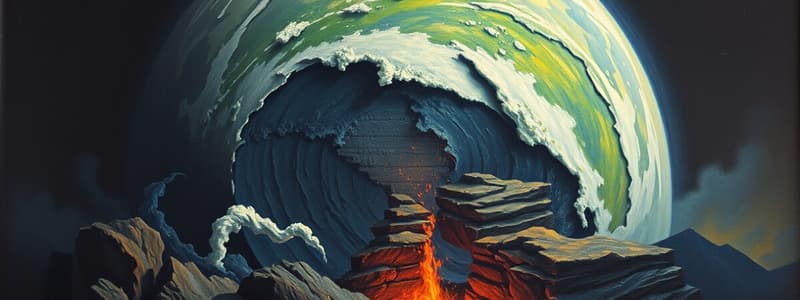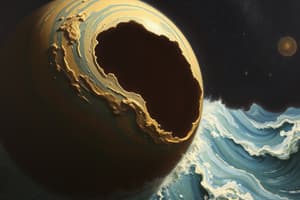Podcast
Questions and Answers
What forms the continents of the Earth?
What forms the continents of the Earth?
- Sima layer
- Sial layer (correct)
- NIFE layer
- Mantle layer
Which material primarily composes the Earth's core?
Which material primarily composes the Earth's core?
- Silica and aluminum
- Copper and zinc
- Magnesium and calcium
- Iron and nickel (correct)
At what depth does the Gutenberg Discontinuity begin?
At what depth does the Gutenberg Discontinuity begin?
- 2800 km (correct)
- 2900 km
- 410 km
- 700 km
What is the approximate temperature range of the Earth's inner core?
What is the approximate temperature range of the Earth's inner core?
Which part of the mantle is cooler and made of solid rocks?
Which part of the mantle is cooler and made of solid rocks?
What is the average thickness of the Earth's mantle?
What is the average thickness of the Earth's mantle?
What happens to S-waves at the outer core?
What happens to S-waves at the outer core?
Which layer of the Earth is the thinnest?
Which layer of the Earth is the thinnest?
What is the outer layer of the Earth called?
What is the outer layer of the Earth called?
Which layer of the Earth is composed primarily of Nickel and Iron?
Which layer of the Earth is composed primarily of Nickel and Iron?
What does the term 'Sial' refer to?
What does the term 'Sial' refer to?
What primarily causes the generation of Earth's heat?
What primarily causes the generation of Earth's heat?
What is the estimated temperature range at the Earth's core?
What is the estimated temperature range at the Earth's core?
Which seismic waves can reach the surface of the Earth?
Which seismic waves can reach the surface of the Earth?
What is the relationship between Sial and Sima in terms of density?
What is the relationship between Sial and Sima in terms of density?
What scientific evidence helps in understanding the composition of the Earth's interior?
What scientific evidence helps in understanding the composition of the Earth's interior?
What is the diameter of the Earth's core?
What is the diameter of the Earth's core?
Which layer of the Earth is said to be the densest?
Which layer of the Earth is said to be the densest?
What does the term 'Lithosphere' refer to?
What does the term 'Lithosphere' refer to?
At what depths is the Mohorovicic Discontinuity (Moho) found beneath oceans and continents?
At what depths is the Mohorovicic Discontinuity (Moho) found beneath oceans and continents?
Which layer of the Earth is responsible for its magnetic field?
Which layer of the Earth is responsible for its magnetic field?
What is the correct order of the Earth's layers from the center to the surface?
What is the correct order of the Earth's layers from the center to the surface?
Which of the following is incorrect about the mantle?
Which of the following is incorrect about the mantle?
What is the temperature range within the mantle?
What is the temperature range within the mantle?
What life-sustaining unit contains all forms of life?
What life-sustaining unit contains all forms of life?
Which layer of the Earth is known to be rigid?
Which layer of the Earth is known to be rigid?
Flashcards are hidden until you start studying
Study Notes
Earth's Structure
- The earth's interior is studied primarily through seismic waves, volcanic materials, and meteorite analysis, not direct excavation.
- P-waves can travel through liquids, while S-waves cannot, indicating the properties of the earth's interior.
- Scientists utilize data on seismic waves to gauge the density, pressure, and temperature of the earth's layers.
- Volcanic materials help reveal the composition of the molten mantle and core.
- Meteorites provide insights into the materials that form the earth, suggesting similarities in composition.
Layers of the Earth
- The earth consists of three main layers: the Crust, Mantle, and Core.
- The crust (Lithosphere) is the outermost and thinnest layer, crucial for sustaining life.
- The lithosphere includes variances like SIAL (continental crust) and SIMA (oceanic crust).
Chemical Composition
- SIAL, composed of silica and aluminum, floats above SIMA, which is denser and consists of silica and magnesium.
- The core, referred to as NIFE, is made up of nickel and iron, found deep within the earth.
Internal Composition
- The Core is dense, about 3486 km in diameter, with temperatures reaching up to 6000°C.
- The Core includes an inner solid phase and an outer molten phase, indicated by S-wave behavior.
- The Mantle is below the crust, averaging 2900 km thick, comprising 84% of the earth’s volume and divided into upper and lower sections.
- The upper mantle is cooler and more solid, while the lower mantle exhibits greater density and heat, ranging from 1000°C to 3700°C.
- The outer crust or lithosphere ranges from 5-60 km thick and is primarily composed of silicates and aluminum.
Key Boundaries
- The Gutenberg Discontinuity, at a depth of 2800 km, marks a significant change in seismic wave behavior between the mantle and core.
- The Mohorovicic Discontinuity (Moho) indicates the boundary between the crust and the mantle, found 8 km beneath oceans and about 32 km beneath continents.
Seismic and Geological Features
- The crust is only 1% of the earth's mass and crucial for all known life.
- The asthenosphere exists at depths of 100-410 km in the mantle, characterized as partially molten.
- The temperature of the oceanic crust varies, with surface temperatures around 0°C, rising deeper into the earth.
Magnetic Field
- The earth's magnetic field originates from the movements of molten iron and nickel within the outer core, especially at polar regions.
Notable Concepts
- Meteorites offer special significance by providing insights into the materials and conditions of the early solar system.
- The layers of the earth are structured in order of Core, Mantle, and then Crust moving outward from the center.
Studying That Suits You
Use AI to generate personalized quizzes and flashcards to suit your learning preferences.




